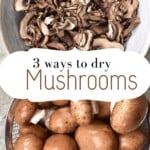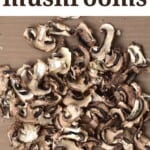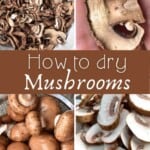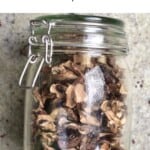This post may contain affiliate links. Please read our disclosure policy.
How to dry mushrooms in the oven or using a dehydrator for long-term storage, whole or as mushroom powder. Learn how to dry, store, and use the dried mushrooms too!
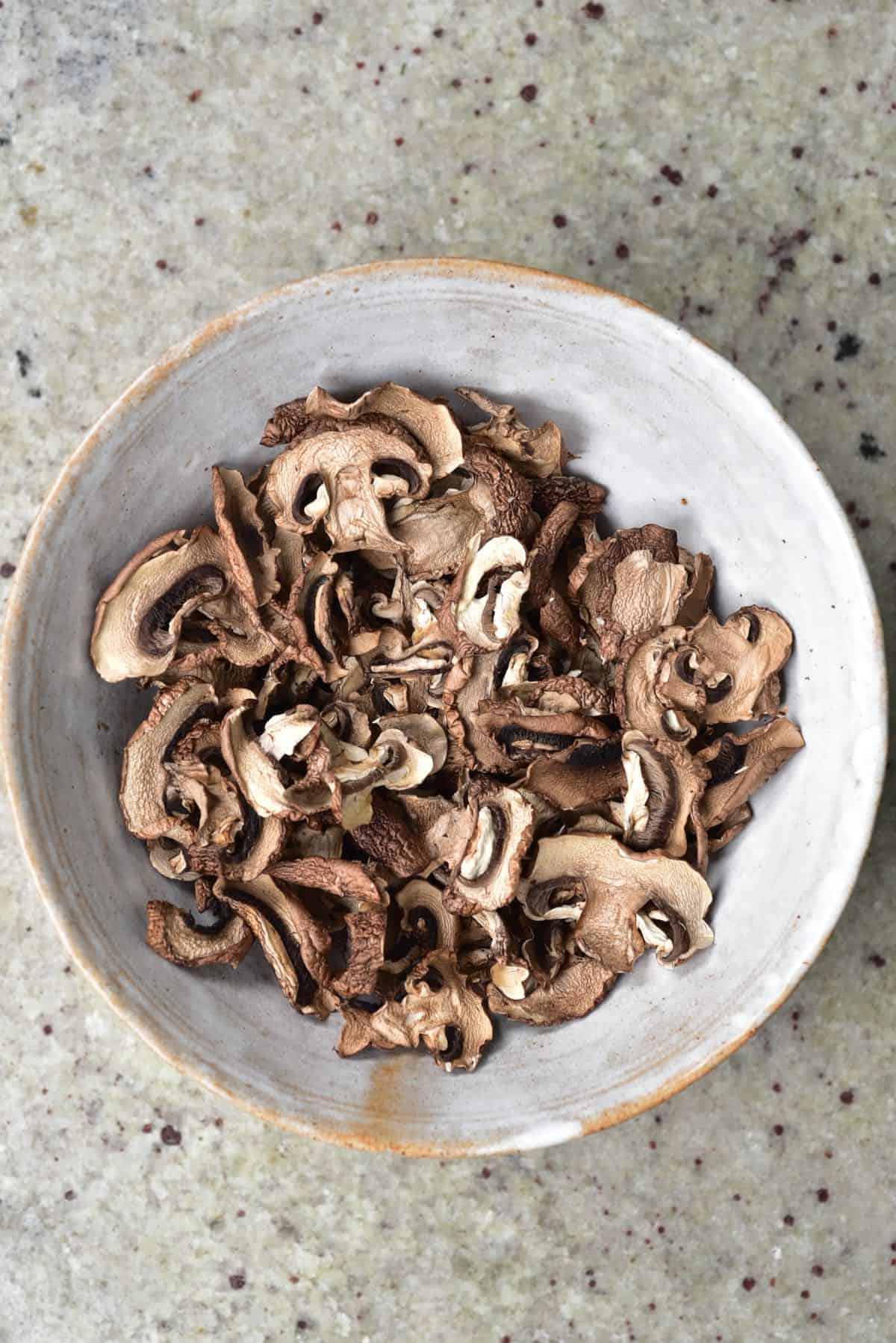
My dehydrator has been having a full-on workout this month – I’ve been busy in the kitchen to share my methods for home-dried herbs like rosemary, thyme, and mint. Now it’s time to learn how to dry mushrooms (for whole dried mushrooms or mushroom powder). All you need are your choice of mushrooms and either a dehydrator or oven – it’s that simple!
I love the flavor of mushrooms and that special ‘umami’ addition that they add to any dish – which only intensifies when the mushrooms are dried! Whether you are someone who forages for mushrooms outdoors or sometimes buys one punnet too many on your favorite ‘shrooms, learning how to dehydrate mushrooms at home is great for preserving and using them in new ways: in broths or as powdered mushrooms for extra flavor.
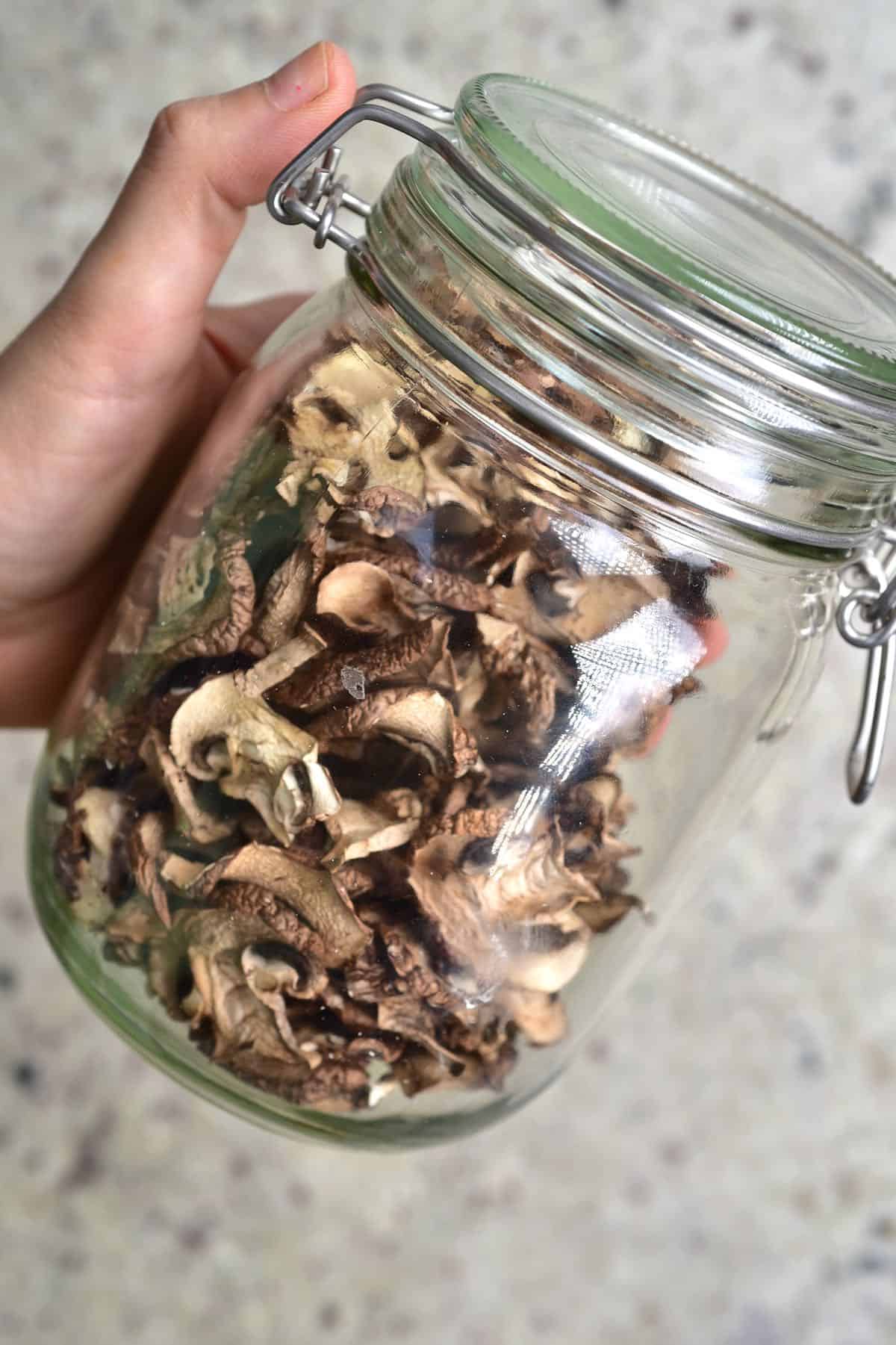
In fact, for all those who hate the texture of ‘shrooms – don’t worry, I know there are plenty of you out there – you may actually still love the flavor and health benefits that powdered mushrooms bring to all kinds of dishes.
Want to save this recipe?
What is Umami? (and MSG)
When I first mentioned using dehydrated mushrooms in my stories on Instagram, I mentioned how I use it to add ‘umami’ to dishes (aka MSG). I got several questions in response, so I thought I’d get into that more here.
Umami is considered a ‘basic taste’ alongside sweet, salty, sour, and bitter. It is described as ‘savoriness,’ literally translated from Japanese to ‘pleasant savory taste.’ The umami elements add a richness to dishes and round out the flavor of a dish. It is commonly introduced to dishes in the form of monosodium glutamate (MSG) or inosine monophosphate (IMP).
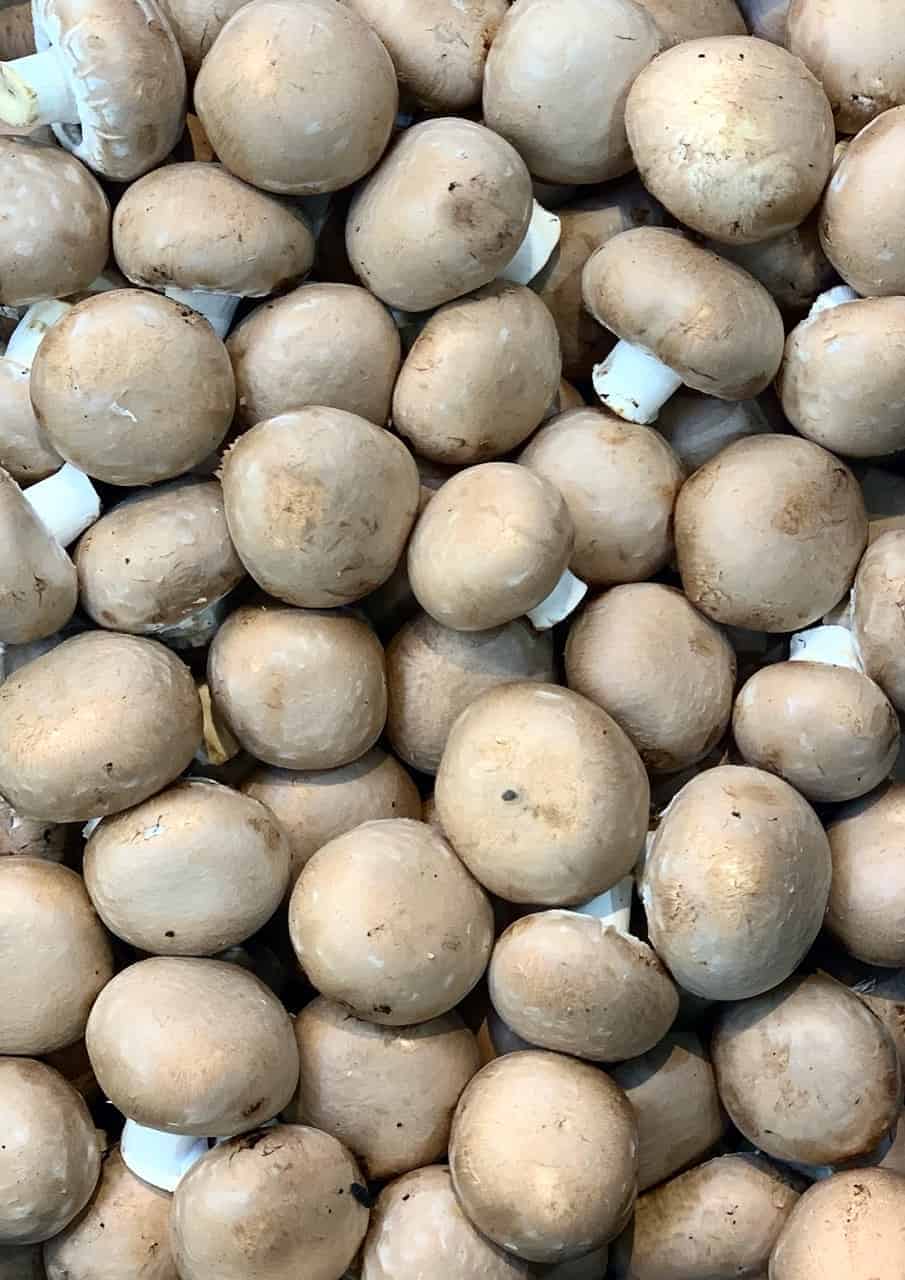
Chemically added ‘umami enhancer’ MSG is highly controversial. However, the idea of foods being naturally rich in ‘umami’ components is very real. Some of the main ingredients said to contain umami (containing one or more of the MSG elements) include soy sauce, tomatoes, yeast extract, meat extract, cheese, and – of course – mushrooms.
When eaten, dishes high in umami flavor contain additional complexity, and the umami flavor is said to last longer than over tastes and provide a mouthwatering effect.
That’s why mushroom powder or dried mushrooms are a great addition to your pantry and a way to add an umami element to any dish. Combine this with other umami-boosting ingredients like soy sauce and/or miso, and you’re in for a flavor explosion (aka umami bomb!).
Top Tips For Drying Mushrooms
- Make sure to only use mushrooms that are fresh (not past their best) and with no black spots or mold.
- If you forage for mushrooms be careful about selecting only species that are edible and non-toxic. Some edible species include Agaricus (common/button), Boletus (Cep/Porcini), etc. It’s best to use a chart or there are even mushroom identification apps you can use on your phone.
How To Dry Mushrooms
First, prepare the mushrooms
Clean the mushrooms – to do this, DON’T use water. Instead, lightly clean them with a kitchen towel or using a gentle brush. If there’s some stubborn dirt, then use a damp kitchen towel.
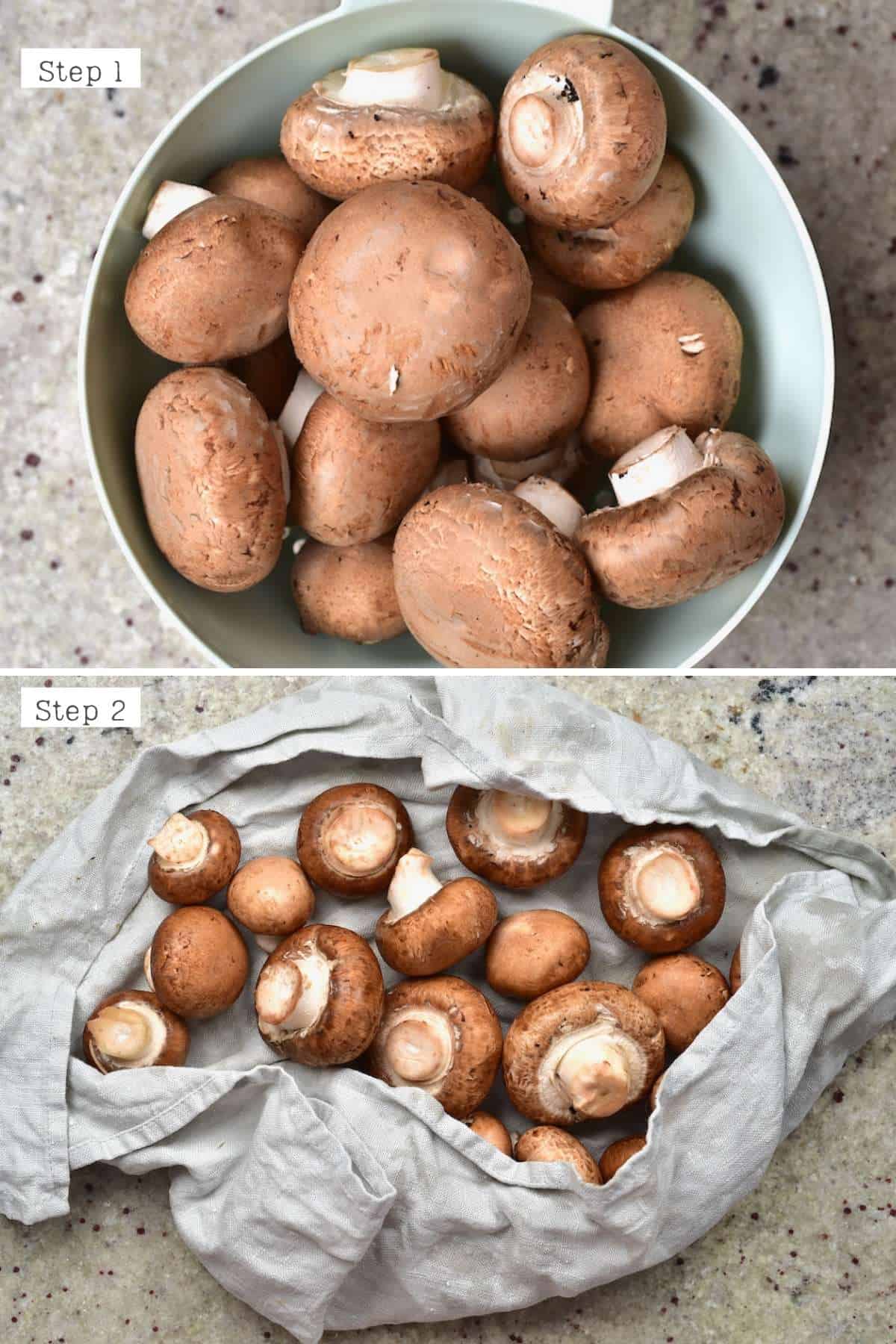
Depending on what variety you’re using, you can choose to dry them whole or sliced (around 1/8″/1cm in thickness). Most mushrooms will need to be sliced though.
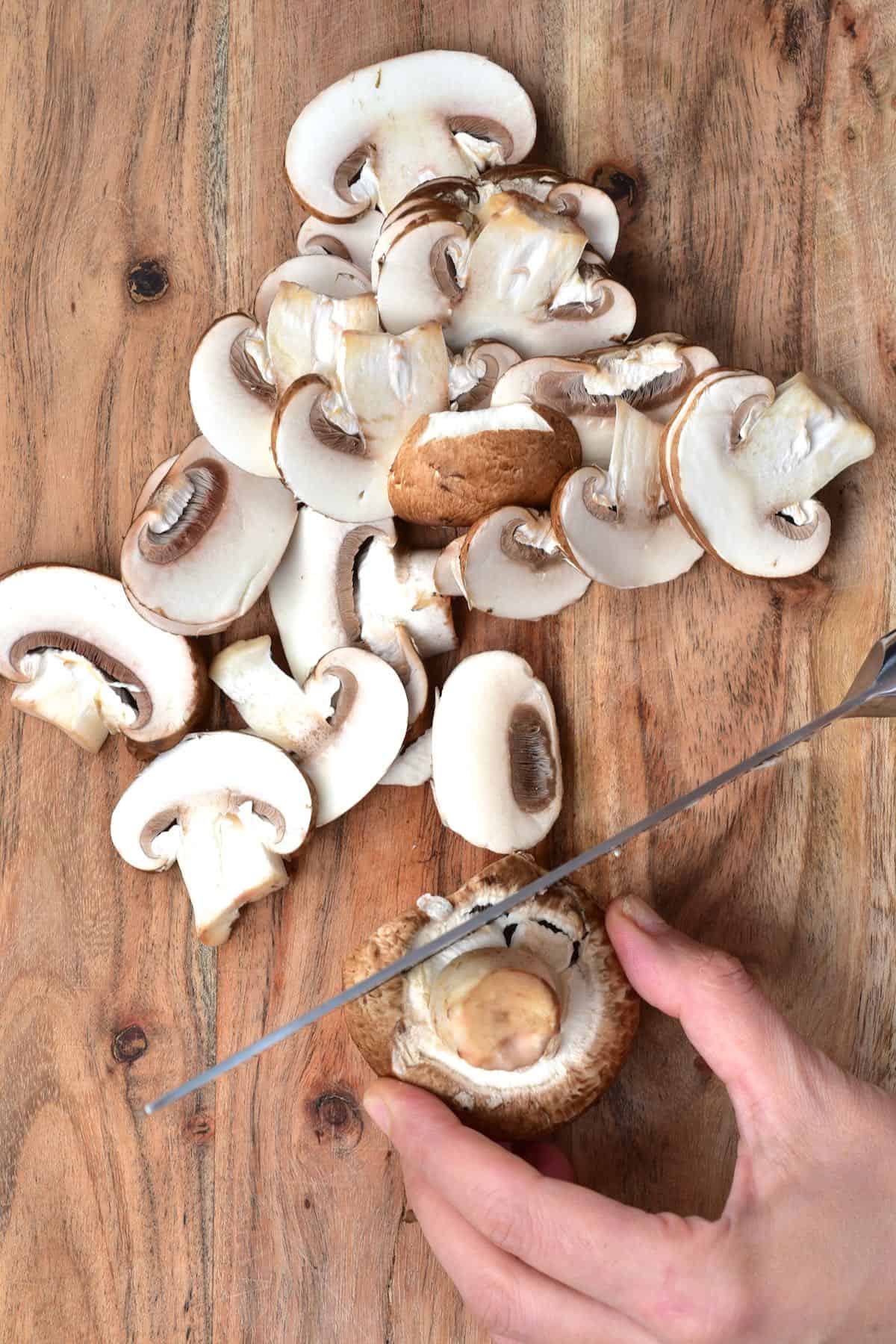
Finally, arrange the mushrooms onto the dehydrator tray/s (for the dehydrator) or parchment-lined baking tray/s (for the oven) in a single layer, with a little space between – for the air to circulate. Make sure to blot the mushrooms with a paper towel before they go in the oven/dehydrator, to remove any other excess water (and avoid them steaming in the oven!).
In The Oven
Dry the mushrooms in the oven at around 130ºF/54ºC for 4-8 hours, flipping them over after 1-2 hours (and repeating this process every 1-2 hours).
If your oven doesn’t go below around 140ºF/60ºC, then it’s a good idea to prop open the door with a heat-proof wooden spoon or potholder. Not only will this bring down the temperature of the oven, but it will also increase air-flow. If the temperature is too high the mushrooms can ‘case harden’ – which means the outer layer will become hard (‘cooked’) and make it harder for the remaining moisture to escape.
It can help speed up the process to pat the mushrooms dry after they’ve been in the oven for 1- 1.5hrs, then turn over the mushrooms and repeat. Repeat this process (removing, blotting, and turning over) until the mushrooms are dry.
Remove the dehydrated mushrooms from the oven and allow them to cool completely. They will continue to crisp up as they cool.
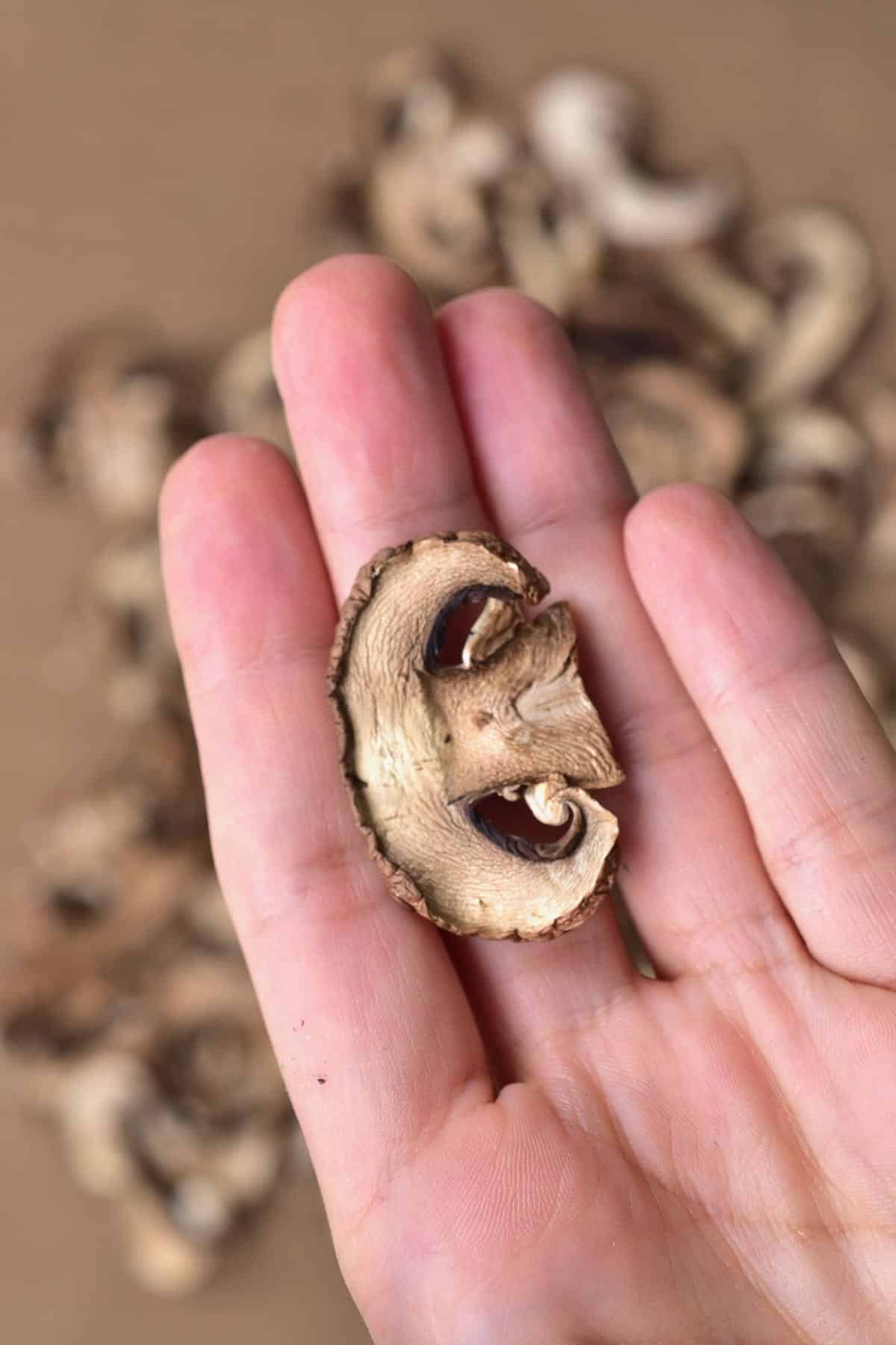
If they aren’t completely dry (they should snap rather than bend and be fairly brittle), you can place them back in the oven for longer.
With A Dehydrator
Dehydrate the mushrooms, in a single layer, at 125ºF/52ºC until the mushrooms are leathery and dry.
This process can take anywhere from 4-12 hours depending on the thickness of the mushrooms, how big your batch is in the machine, and even the humidity. It’s worth checking on them every hour or so.
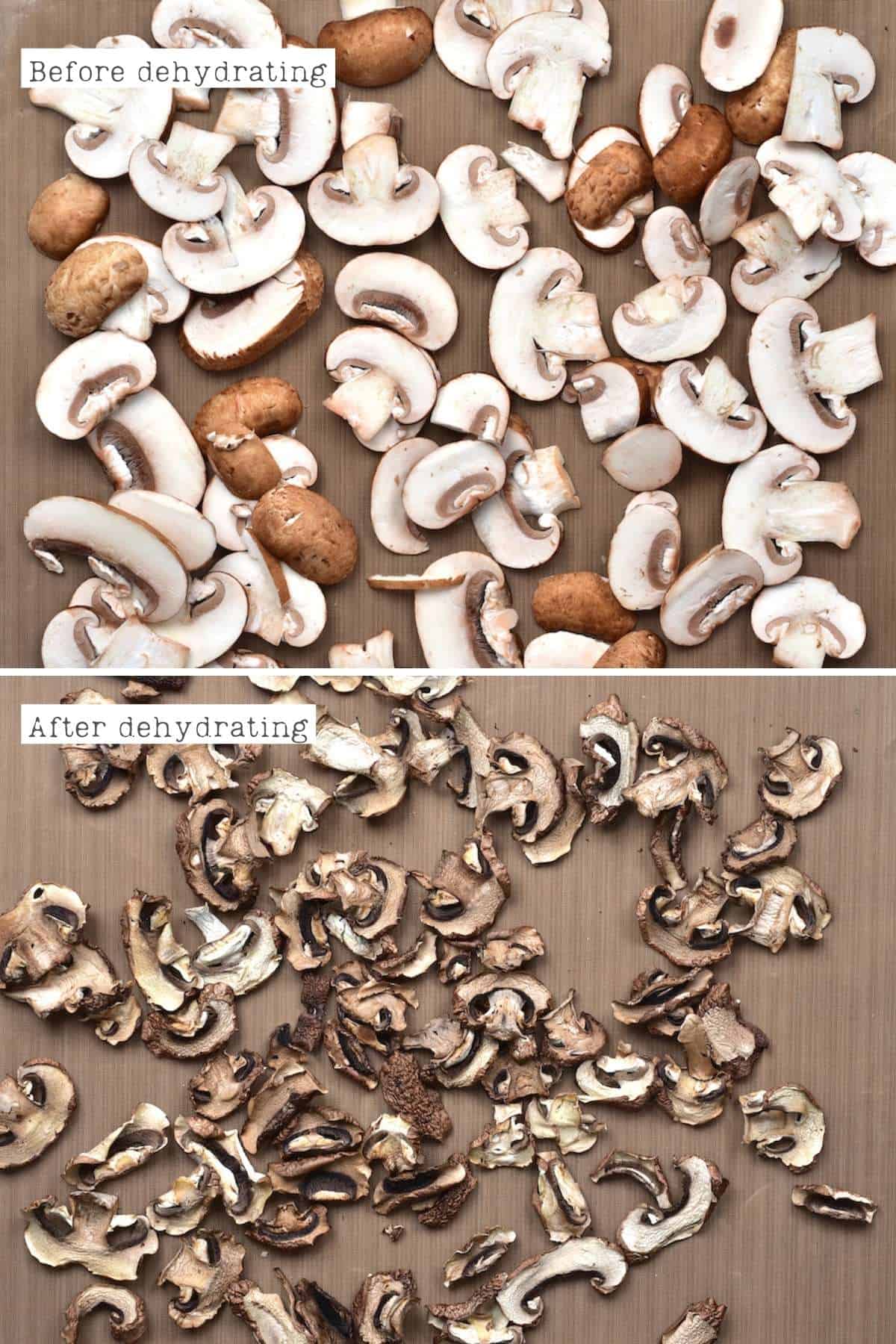
How To Make Mushroom Powder
Place the dried mushrooms in a high-speed blender/food processor and blend into a fine powder. You may want to sieve the powder and re-blend any larger bits or separate them into different containers.
To make a quick mushroom seasoning: add some salt to the mushrooms when blending. It can also be great to use a combination of dried mushrooms for different flavors.
Optional add-ins: garlic powder, red pepper flakes, or chili powder.
Note: Dried shiitake is a particularly rich source of umami flavor from guanylate – it can greatly enhance the flavor of the dish it’s added to.
How To Store
Store the dried mushrooms in an airtight container (I use glass jars) in a cool, dark place away from direct sunlight for up to 12 months.
The mushroom powder will remain at its peak flavor for 6 months but will be fine for up to 12 months.
Top Tip: in the immediate days after drying the mushrooms, check for moisture in the container (condensation, etc.). If there is, then repeat the drying process for a little longer. Otherwise, the entire batch of dried mushrooms will become moldy.
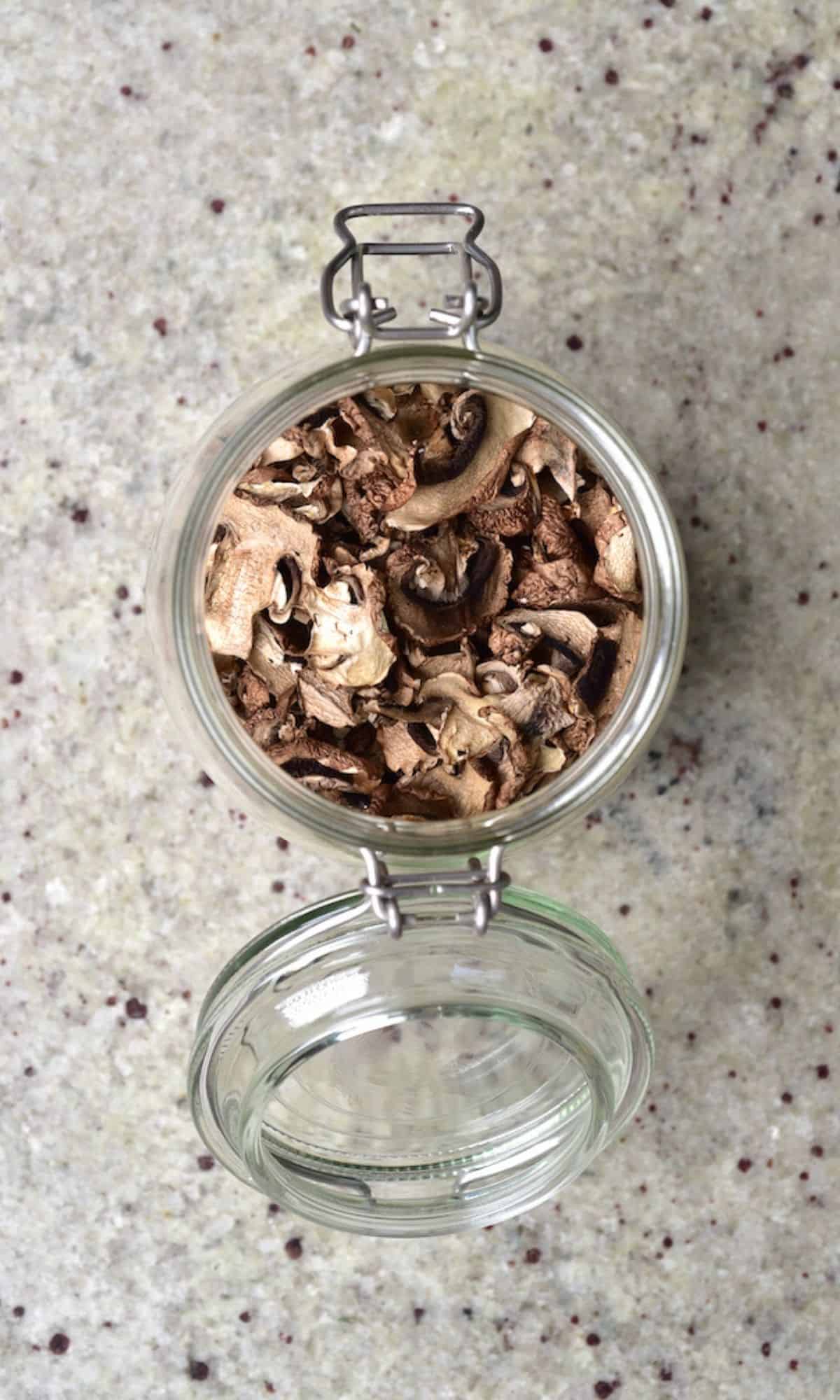
How To Use
The dried mushrooms are great for adding to stock and soup bases. However, dehydrated mushrooms can also be reconstituted and used in many of the same ways you’d use fresh mushrooms: dumplings, stir-fry, risotto, stews, omelettes, savory oatmeal, pasta sauce, etc.
Using the powdered mushrooms is a great way to get the woody, umami flavor without the mushroom’s texture.
Mushroom Powder Uses
- Use as a seasoning to add umami to tons of dishes – the way you would a general-purpose seasoning.
- Within soups, stews, and stocks – like this Japanese-inspired Ramen Noodle Soup.
- Within sauces – like pasta sauce or gravies.
- Egg dishes – like scrambled eggs or omelettes.
- Within a dry rub or marinade for proteins – like meat or tofu.
- Within dishes like meatballs, burgers, etc. – like these Healthy Mushroom & Lentil Vegan Meatballs.
- Depending on the mushroom variety, it can even be added to your morning coffee/smoothie for healthful benefits.
FAQs
Soak the dried mushrooms in lukewarm water for between 30-60 minutes to rehydrate them or 20-30 minutes in boiling water. Optionally, then rinse the soaked mushrooms.
Even better, strain and use the soaking liquid in the cooking as it’s full of flavor (or freeze it for later), and the reconstituted mushrooms have practically the same texture as they did when fresh!
Note: the mushrooms will retain more flavor when soaked in warm/room temp water.
When dried and stored correctly, dried mushrooms won’t become moldy or ‘go bad’ as such (so you don’t have to worry about becoming poisoned). However, their quality will diminish over time.
Yes, you can. You DON’T NEED to, but it can retain the best flavor for longer. Just store the mushroom powder in an airtight, freezer-safe container (as any liquid introduced to the powder will ruin the batch).
I haven’t tested exactly how long freezing will retain the freshness of mushrooms powder, but I assume somewhere between 12-18 months will be the peak flavor.
Because mushrooms have such a high water content (around 92%), the ratio you need when reconstituting dried mushrooms is somewhere around 9:1. However, when trying to substitute fresh mushrooms for dried and reconstituted, it works out somewhere around 5:1/6:1.
– For every 1lb/450g of fresh mushrooms that a recipe calls for, use about 3oz/85g dried (and then reconstituted)
– 1 cup fresh mushrooms = 1/3 oz/10g dried (then reconstituted)
– 1Tbsp powdered mushrooms = around 4oz/110g fresh mushrooms.
Related DIYs
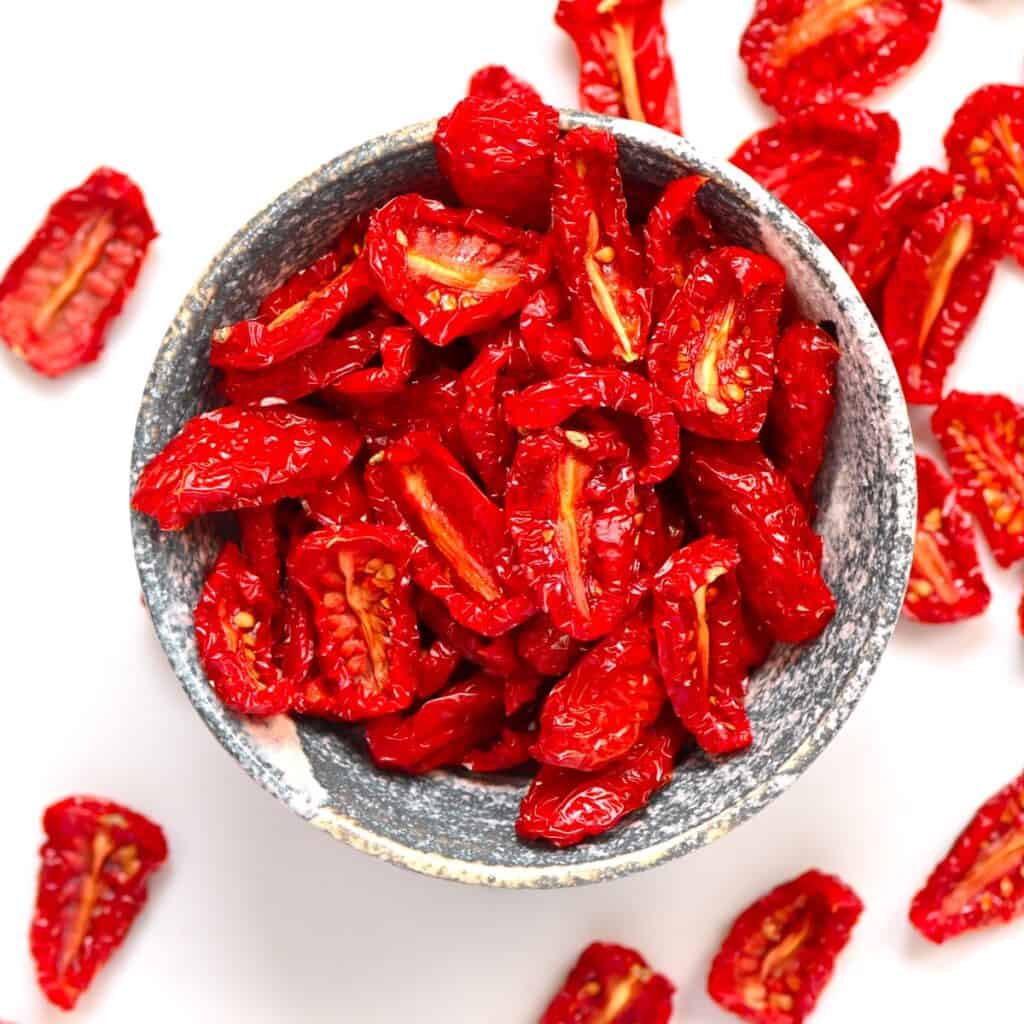
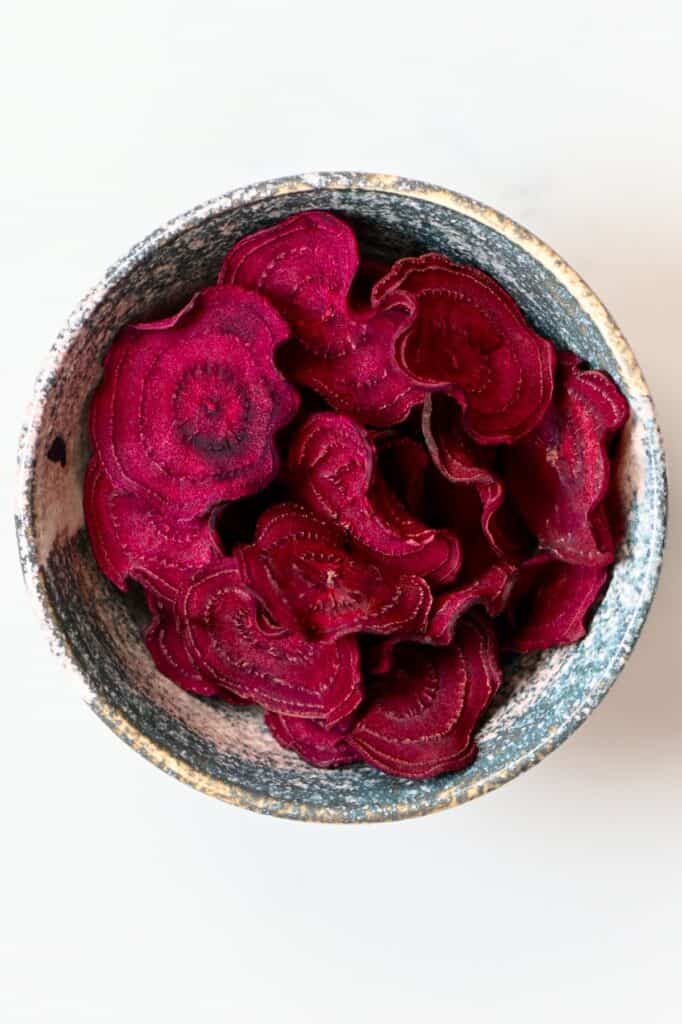
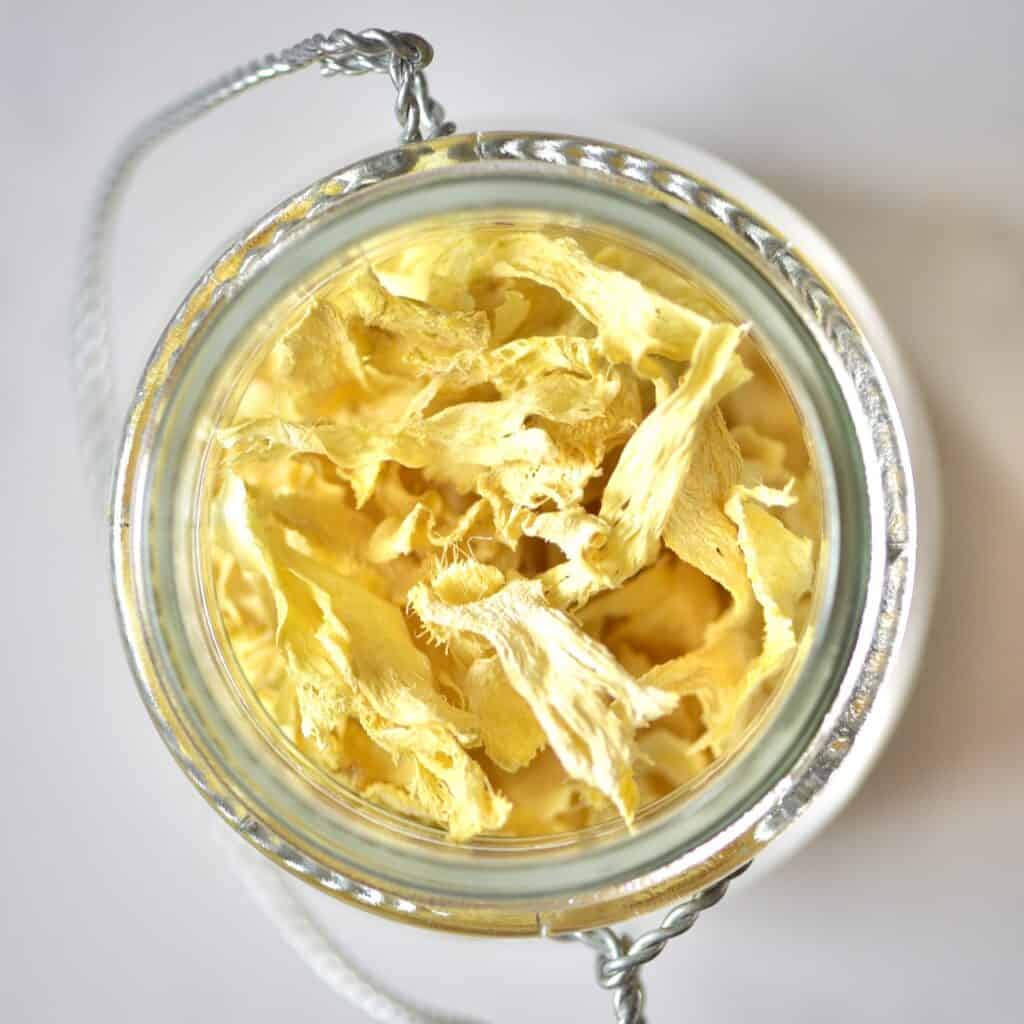
- How to Make ‘Sun-Dried’ Tomatoes (In Oven or Dehydrator)
- Beetroot Chips (Baked or Dehydrated)
- How To Make Crispy Ginger Chips
- How To Make Coconut Flakes (Coconut Chips)
- DIY Chili Flakes (Oven + Dehydrator)
- Easy French Fry Seasoning
If you try this dehydrated mushrooms/mushroom powder DIY, then let me know your thoughts and questions in the comments. I’d also really appreciate a recipe rating and would love to see your recreations – just tag @AlphaFoodie.
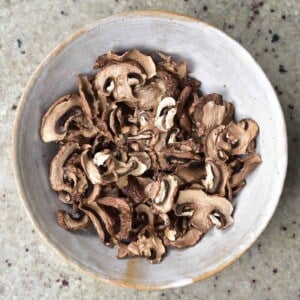
How To Dry Mushrooms (2 Methods)
Equipment
Ingredients
- 1.5 pounds mushrooms
This will yield about 2 oz/55 g
Instructions
First, prepare the mushrooms
- Clean the mushrooms – to do this, DON'T use water. Instead, lightly clean them with a kitchen towel or using a gentle brush. If there's some stubborn dirt, then use a damp kitchen towel.
- Depending on what variety you're using, you can choose to dry them whole or sliced (around 1/8"/1cm in thickness). Most mushrooms will need to be sliced.
- Arrange the mushrooms onto the dehydrator tray/s (for the dehydrator) or parchment-lined baking tray/s (for the oven) in a single layer, with a little space between – for the air to circulate. Make sure to blot the mushrooms with a paper towel before they go in the oven/dehydrator, to remove any other excess water (and avoid them steaming in the oven!).
In The Oven
- Dry the mushrooms in the oven at around 130ºF/54ºC for 4-8 hours, flipping them over after 1-2 hours (and repeating this process every 1-2 hours), and blotting with a paper towel to remove excess liquid. If your oven doesn't go below around 140ºF/60ºC, then it's a good idea to prop open the door with a heat-proof wooden spoon or potholder. Not only will this bring down the temperature of the oven, but it will also increase air-flow. If the temperature is too high the mushrooms can 'case harden' – which means the outer layer will become hard ('cooked') and make it harder for the remaining moisture to escape.
- Remove the dehydrated mushrooms from the oven and allow them to cool completely. They will continue to crisp up as they cool.If they aren't completely dry (they should snap rather than bend and be fairly brittle), you can place them back in the oven for longer.
With A Dehydrator
- Dehydrate the mushrooms, in a single layer, at 125ºF/52ºC until the mushrooms are leathery and dry.This process can take anywhere from 4-12 hours depending on the thickness of the mushrooms, how big your batch is in the machine, and even the humidity. It's worth checking on them every hour.
How To Make Mushroom Powder
- Place the dried mushrooms in a high-speed blender/food processor and blend into a fine powder. You may want to sieve the powder and re-blend any larger bits or separate them into different containers.
- To make a quick mushroom seasoning: add some salt to the mushrooms when blending. It can also be great to use a combination of dried mushrooms for different flavors.Optional add-ins: garlic powder, red pepper flakes, or chili powder
How To Store
- Store the dried mushrooms in an airtight container (I use glass jars) in a cool, dark place away from direct sunlight for up to 12 months.The mushroom powder will remain at its peak flavor for 6 months but will be fine for up to 12 months.Top Tip: in the immediate days after drying the mushrooms, check for moisture in the container (condensation, etc.). If there is, then repeat the drying process for a little longer. Otherwise, the entire batch of dried mushrooms will become moldy.
Notes
- Make sure to only use mushrooms that are fresh (not past their best) and with no black spots or mold.
- If you forage for mushrooms be careful about selecting only species that are edible and non-toxic. Some edible species include Agaricus (common/button), Boletus (Cep/Porcini), etc. It’s best to use a chart or there are even mushroom identification apps you can use on your phone.
Nutrition
Nutrition information is automatically calculated, so should only be used as an approximation.

